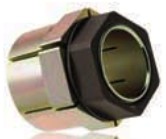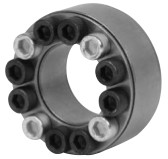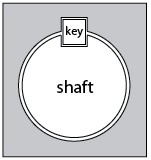Difference between revisions of "Attaching to a shaft"
From Mech
Jump to navigationJump to search| Line 1: | Line 1: | ||
There are many ways to attach to a shaft (e.g., a motor shaft). Below are a few examples. |
There are many ways to attach to a shaft (e.g., a motor shaft). Below are a few examples. |
||
* Keyway [[Image:keyway.jpg]] |
|||
| ⚫ | |||
<br clear=all> |
|||
| ⚫ | * [http://www.nmbtc.com/bearings/engineering/fitting.html Press fit or interference fit]; see also the [http://en.wikipedia.org/wiki/Interference_fit wikipedia page] (note: be careful not to apply axial press forces large enough to damage the motor; the shaft should be supported [clamped] during the press to avoid this) |
||
* [http://en.wikipedia.org/wiki/Set_screw Set screws] |
* [http://en.wikipedia.org/wiki/Set_screw Set screws] |
||
[[Image:setscrew.jpg]] |
|||
To get good holding torque with set screws, they have to be clamped down hard on the shaft, which can damage the shaft. For larger holding torques, a better option is to have a friction fit around the entire shaft. This can be achieved by compliant elements that squeeze onto the shaft as one or more screws are tightened. |
|||
<br clear=all> |
<br clear=all> |
||
* |
* Split clamp [[Image:split-clamp.gif]] [[Image:splitclamp2.jpg]] |
||
<br clear=all> |
|||
* Trantorque bushing [[Image:trantorque.jpg]] As the nut is tightened, the inner diameter shrinks, clamping on to the shaft, and the outer diameter grows, clamping on to the inside diameter of the component. |
|||
<br clear=all> |
<br clear=all> |
||
* Shaft locks and taper locks [[Image:shaftlock.jpg]] Typically two cylindrical pieces are put around the shaft. As they are screwed together, an inner taper on one of the pieces clamps on to the shaft. |
|||
* Epoxy |
* Epoxy |
||
| Line 12: | Line 18: | ||
* [http://www.fennerdrives.com Fenner Drives] |
* [http://www.fennerdrives.com Fenner Drives] |
||
* [http://www.mcmaster.com McMaster-Carr] (split collars, trantorque bushings) |
* [http://www.mcmaster.com McMaster-Carr] (split collars, shaft couplers, trantorque bushings) |
||
* [http://www.sdp-si.com Stock Drive Products] (shaftloc and other couplings) |
* [http://www.sdp-si.com Stock Drive Products] (shaftloc and other couplings) |
||
* [http://www.lovejoy-inc.com Lovejoy] |
* [http://www.lovejoy-inc.com Lovejoy] |
||
Revision as of 15:20, 20 June 2010
There are many ways to attach to a shaft (e.g., a motor shaft). Below are a few examples.
- Press fit or interference fit; see also the wikipedia page (note: be careful not to apply axial press forces large enough to damage the motor; the shaft should be supported [clamped] during the press to avoid this)
- Set screws
 To get good holding torque with set screws, they have to be clamped down hard on the shaft, which can damage the shaft. For larger holding torques, a better option is to have a friction fit around the entire shaft. This can be achieved by compliant elements that squeeze onto the shaft as one or more screws are tightened.
To get good holding torque with set screws, they have to be clamped down hard on the shaft, which can damage the shaft. For larger holding torques, a better option is to have a friction fit around the entire shaft. This can be achieved by compliant elements that squeeze onto the shaft as one or more screws are tightened.
- Trantorque bushing
 As the nut is tightened, the inner diameter shrinks, clamping on to the shaft, and the outer diameter grows, clamping on to the inside diameter of the component.
As the nut is tightened, the inner diameter shrinks, clamping on to the shaft, and the outer diameter grows, clamping on to the inside diameter of the component.
- Shaft locks and taper locks
 Typically two cylindrical pieces are put around the shaft. As they are screwed together, an inner taper on one of the pieces clamps on to the shaft.
Typically two cylindrical pieces are put around the shaft. As they are screwed together, an inner taper on one of the pieces clamps on to the shaft. - Epoxy
Some companies that provide shaft couplings:
- Fenner Drives
- McMaster-Carr (split collars, shaft couplers, trantorque bushings)
- Stock Drive Products (shaftloc and other couplings)
- Lovejoy
- Ringfeder


